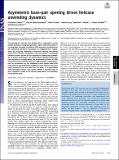Files in this item
Asymmetric base-pair opening drives helicase unwinding dynamics
Item metadata
| dc.contributor.author | Colizzi, Francesco | |
| dc.contributor.author | Perez-Gonzalez, Cibran | |
| dc.contributor.author | Fritzen, Remi | |
| dc.contributor.author | Levy, Yaakov | |
| dc.contributor.author | White, Malcolm F. | |
| dc.contributor.author | Penedo, J. Carlos | |
| dc.contributor.author | Bussi, Giovanni | |
| dc.date.accessioned | 2019-10-21T08:30:28Z | |
| dc.date.available | 2019-10-21T08:30:28Z | |
| dc.date.issued | 2019-11-05 | |
| dc.identifier | 261540565 | |
| dc.identifier | d7604670-ce7a-4053-9b6c-fcfee7c369cc | |
| dc.identifier | 85074462526 | |
| dc.identifier | 31628254 | |
| dc.identifier | 000494457400017 | |
| dc.identifier.citation | Colizzi , F , Perez-Gonzalez , C , Fritzen , R , Levy , Y , White , M F , Penedo , J C & Bussi , G 2019 , ' Asymmetric base-pair opening drives helicase unwinding dynamics ' , Proceedings of the National Academy of Sciences of the United States of America , vol. 116 , no. 45 , pp. 22471-22477 . https://doi.org/10.1073/pnas.1901086116 | en |
| dc.identifier.issn | 0027-8424 | |
| dc.identifier.other | ORCID: /0000-0003-1543-9342/work/63716502 | |
| dc.identifier.other | ORCID: /0000-0003-3457-8364/work/63716900 | |
| dc.identifier.other | ORCID: /0000-0002-5807-5385/work/74872769 | |
| dc.identifier.uri | https://hdl.handle.net/10023/18714 | |
| dc.description | F.C. thanks Laurène Bastet, Gaston Giroux, and the Bibliothèque Roger-Maltais at UdeS for providing infrastructures and support. F.C. acknowledges sabbatical funding (2013 to 2015) from Romano Colizzi and Maria Gaudio in Taranto, Italy, and has received support by the European Union’s Horizon 2020 Research and Innovation Programme under Marie Skłodowska-Curie Grant 752415. C.P.-G. thanks the Engineering and Physical Sciences Research Council (EPSRC) and the University of St. Andrews for financial support. Work in M.F.W. and J.C.P.’s laboratories was supported by Grant 091825/Z/10/Z from the Wellcome Trust. G.B.’s laboratory has received funding from the European Research Council (ERC) under the European Union’s Seventh Framework Programme (FP/2007-2013)/ERC Grant 306662, S-RNA-S. | en |
| dc.description.abstract | The opening of a Watson–Crick double helix is required for crucial cellular processes, including replication, repair, and transcription. It has long been assumed that RNA or DNA base pairs are broken by the concerted symmetric movement of complementary nucleobases. By analyzing thousands of base-pair opening and closing events from molecular simulations, here, we uncover a systematic stepwise process driven by the asymmetric flipping-out probability of paired nucleobases. We demonstrate experimentally that such asymmetry strongly biases the unwinding efficiency of DNA helicases toward substrates that bear highly dynamic nucleobases, such as pyrimidines, on the displaced strand. Duplex substrates with identical thermodynamic stability are thus shown to be more easily unwound from one side than the other, in a quantifiable and predictable manner. Our results indicate a possible layer of gene regulation coded in the direction-dependent unwindability of the double helix. | |
| dc.format.extent | 7 | |
| dc.format.extent | 1306154 | |
| dc.language.iso | eng | |
| dc.relation.ispartof | Proceedings of the National Academy of Sciences of the United States of America | en |
| dc.subject | Double helix | en |
| dc.subject | Nucleic acids | en |
| dc.subject | Simulations | en |
| dc.subject | Experiments | en |
| dc.subject | Unwindability | en |
| dc.subject | QH301 Biology | en |
| dc.subject | QH426 Genetics | en |
| dc.subject | DAS | en |
| dc.subject | BDC | en |
| dc.subject | R2C | en |
| dc.subject.lcc | QH301 | en |
| dc.subject.lcc | QH426 | en |
| dc.title | Asymmetric base-pair opening drives helicase unwinding dynamics | en |
| dc.type | Journal article | en |
| dc.contributor.sponsor | The Wellcome Trust | en |
| dc.contributor.sponsor | The Wellcome Trust | en |
| dc.contributor.institution | University of St Andrews. School of Physics and Astronomy | en |
| dc.contributor.institution | University of St Andrews. Biomedical Sciences Research Complex | en |
| dc.contributor.institution | University of St Andrews. School of Biology | en |
| dc.contributor.institution | University of St Andrews. Centre for Biophotonics | en |
| dc.identifier.doi | https://doi.org/10.1073/pnas.1901086116 | |
| dc.description.status | Peer reviewed | en |
| dc.identifier.url | https://www.pnas.org/lookup/suppl/doi:10.1073/pnas.1901086116/-/DCSupplemental | en |
| dc.identifier.grantnumber | 091825/Z/10/Z | en |
| dc.identifier.grantnumber | 091825/Z/10/Z | en |
This item appears in the following Collection(s)
Items in the St Andrews Research Repository are protected by copyright, with all rights reserved, unless otherwise indicated.

